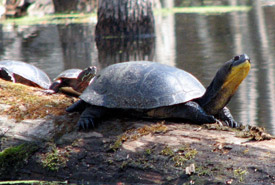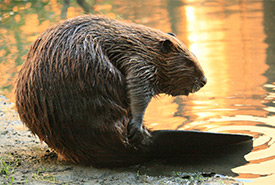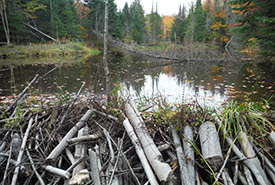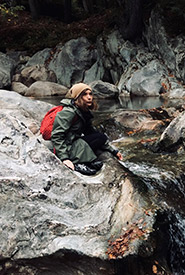The challenge of beaver dams in Blanding's turtle habitat

Blanding's Turtle (Photo by NCC)
The beaver and the turtle: it sounds like a Jean de LaFontaine fable, but for my colleague Milaine Saumur, the Nature Conservancy of Canada’s (NCC’s) project manager in the Outaouais, Quebec, it's a true story.
A couple of months ago she asked for my help, as she tried to attract people from the municipal world to a workshop about alternative solutions to the dismantling of beaver dams.
As a member of NCC’s communications team, part of my work is indeed to assist my scientist co-workers in spreading their message to the right audience. So I gave her the best advice that I could, but above all, I thought “That’s a story I want to share!”
I had no idea that destroying beaver dams threatened Blanding's turtle survival. I must confess that I find beavers adorable, but I learned that they can cause serious headaches for landowners and municipalities that have dams on their property. That’s why NCC has come to their rescue with a series of awareness workshops to help ensure the survival of Blanding's turtle.
Beavers build dams, which create wetlands, to increase their food resource area and protect themselves from predators. In addition to regulating, filtering and purifying runoff water, these wetlands are also useful for other species; they promote the nesting and feeding of waterfowl, and also benefit several types of fish, amphibians, reptiles and even some mammals. A few years ago, a study on the movement of Blanding's turtle, a species designated threatened in Quebec since 2009, revealed that more than 90 per cent of their habitat is in ponds created, maintained or regulated by beavers.
Related blog posts
However useful they may be, these dams can suddenly give way, flooding land and infrastructure. This is why they are sometimes destroyed by local residents. The option of destroying dams, besides being effective only in the short term (since beavers will return to rebuild their dam if they find the environment favourable) is a threat to Blanding's turtle's survival.

Beaver (Photo by Cheryl Reynolds)
This was explained during a presentation given by NCC biologists Milaine Saumur and Caroline Gagné in Clarendon, Outaouais, last fall. They discussed alternatives dismantling beaver dams, including preventative structures designed to protect culverts and the installation of a water level control system upstream of a dam.
During the second part of the workshop, the small group went into the field, guided by Jean Fink, biologist at the Centre d'enseignement et de recherche en foresterie de Sainte-Foy inc. (CERFO), so they could observe a water level control system in action that was implemented in the fall of 2018. The demonstration illustrated how this system works and its effectiveness.

Beaver dam, Ottawa Valley (Photo by NCC)
Patricia Hobbs, Clarendon's director general, attended one of the workshops and provided some feedback. “We found the presentation to be informative and the preventative measures described to be very logical,” she says. “We appreciated the approach that was taken, which in our opinion took into consideration both the welfare of many species, but also the rights and concerns of landowners. We will definitely be pursuing some of these techniques in the future.”
As this solution can cost between $3,000 and $6,000, NCC and CERFO can look into obtaining funding for non-urgent projects located in Blanding's turtle habitat. If the situation is urgent, the guideline is to consult a local expert, such as Éco-odyssée, Solution nature, Gesnat or wildlife management companies, who will be able to implement interventions adapted to the situation.
Twelve citizens and 33 people from the municipal sector attended the workshops in 2018, suggesting that there is a genuine interest in finding new solutions to this issue. “There is still a lot of work to be done to raise awareness, but we hope that the message will find its way,” says Milaine.
I hope so too, and I hope to maybe see some installations of water level control systems pop up in the near future.
Thank you to our partners
- Environment Canada via the Environmental Damages Fund
- Fondation de la faune du Québec
- U.S. Fish and Wildlife Service
- L’Équipe de rétablissement des tortues du Québec


